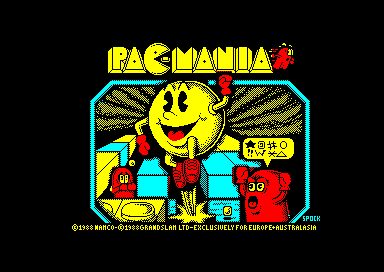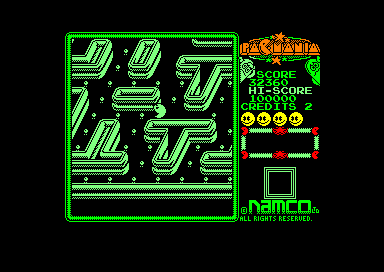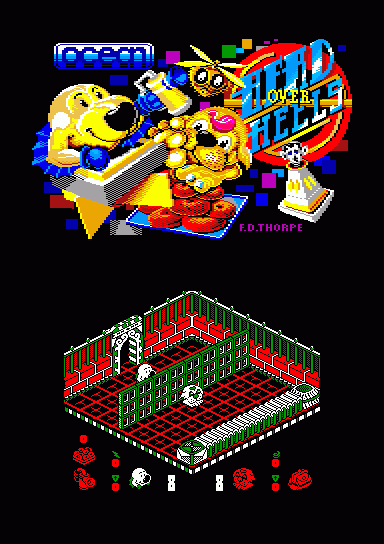Difference between revisions of "Speccy Port"
(→Rushed and Lazy) |
(→The 3 levels of Speccy portages) |
||
| Line 89: | Line 89: | ||
=The 3 levels of Speccy portages= | =The 3 levels of Speccy portages= | ||
| + | |||
| + | |||
| + | Of course the level of Fail could greatly depend on whatever strategy the programmers/grapists used to get rid of the poor Video speccy's specificities... | ||
| + | |||
| + | A monochrome game could remain monochrome or be recoloured on CPC. | ||
| + | |||
| + | A coloured game with design-wise graphics (character based design) could be the exact same yet with even less colours... | ||
| + | |||
| + | Or Tiles/sprites could simply be completely well re-done/re-drawn, even in mode0 sometimes... | ||
==Rushed and Lazy== | ==Rushed and Lazy== | ||
Revision as of 21:55, 17 June 2010
A Speccy Port or Spectrum port is the name given to a game which has been converted directly from the Sinclair Spectrum with little or no changes to the Amstrad CPC. Often the Amstrad version ended up fairing worse than the original Spectrum version.
Contents
Why ?
The ZX Spectrum shared the same CPU as the Amstrad and had a simple graphics display. The Spectrum was very popular with the Amstrad having much less market share.
To "gain" time and money, the Spectrum code was re-used.
The Amstrad screen was reduced in size to match the Spectrums and often most of the colour was removed. Most spectrum ports were done in Video Mode 1 (4 colour mode), because the resolution of this mode matched the resolution of the Spectrum, and this allowed the use of the same graphics.
Speccy port was also seen on the MSX and Enterprise.
Some games actually ended up pretty decent.
But so many of them got theyr graphic totally unchanged, displaying some kind of colour attributes "artefacts", proof of the faulty portage.
A typical Spectrum port to the Amstrad is said to have been done in 3 days.
It is not known if they lacked the knowledge or will to develop a better CPC version, or simply didn't have the tools to do so.
Games Cross development
The serious games company often released their games on multiple Games Platform (=Computers or Consoles).
Many aimed mostly at their home market, as Europe and product Exportation/distribution from foreign countries weren't well established at the time.
This result in different priorities concerning the games development from countries to countries.
As British Market was dominated by Speccy, the CPC had to deal with more Speccy ports than needed.
But in a country such as France (and Speain too) were the CPC was the Dominant 8 bit machine, Developpers used different method.
Often an Atari ST was used for Cross Development in France.
More info at Games Crossdev.
Consequences
The Amstrad CPC was one of the best 8 bit computer of his time in term of graphical capabilities. But this had a price...well, a weight in term of CPU ressources. As so many games were ported from the "inferior" Spectrum, the Amstrad range could hardly benefit from its main advantage.
Quite disapointing, when you are the happy possessor of a "powerfull" Amstrad CPC 6128...with a fast disc drive and 2x64Ko of Ram, a good colour palette of 27 shades... to get a games designed for a cassette 48Ko almost mono-colour computer, and not that compatible in fact...
As a result, so many games were slowler, painfully animated, with a bad gameplay... AND had badly ported graphics too.
- C64 had better sounds, scrollings and Sprites capabilities.
- Spectrum had less power taken by Video RAM, so could handlle animation or scrolling more easily, with less need to precisely programm with exceptionnal care.
Amstrad had to be specifically programmed in order to get good animations. Yet Speccy ports weren't re-programmed in such way. Also, even graphical datas were larger than their Speccy's counterpart...
Also, games in Mode1 could have been good despite the lack of colours...if only those colours were used properly more often.
As a result, most Speccy and C64 fans rarely give Amstrad the credit it deserves.
On a more positive tone, those speccy ports had the merit to exist, or else Amstrad may have a lighter games catalogue.
And as said above, those games weren't all bad, just a bit frustrating most of time.
Games with no need of scrollings and with re-coded graphics actually could be good...
It is also a mis-conception to believe the screen was down-sized in those games to gain processor ressources... It was only done to use the Speccy graphics more easily, and we can doubt the code was (re-)designed so such a screen reduction would even gain CPU ressources.
Examples
- PacMania
Typical exemple, yet it managed to be a nice game despite this.
The title screen and HUD show the attributes and were almost completly unchanged, yet with less colours on screen than the Speccy version.
Ironically, the game manages to display 6 colours in the 4 colours Mode1... Yet the game's area remains completely monocolour (coded in 1 bit) and "colour attributes artefacts" are still present..
- Head over heels
On the other hand, this one was the prime exemple of what every speccy port should have been. Even the C64 version was totally like the Speccy version (monocolor game's area) while the Amstrad graphics were perfectly recoloured to use so well the lack of colour attributes. Also as this games didn't need scrollings, the animation was almost as good as in other 8 bit versions, and colour palette often changed inks, to actually get a colourfull feeling all along the game.. Head Over Heels
- Black Tiger : Bad, bad, bad, such a shame as the Arcade game was awesome.
- R-Type : disapointing, yet decent.
- Deflektor : exemple of a good speccy "cross development", thanks to a clever concept.
The 3 levels of Speccy portages
Of course the level of Fail could greatly depend on whatever strategy the programmers/grapists used to get rid of the poor Video speccy's specificities...
A monochrome game could remain monochrome or be recoloured on CPC.
A coloured game with design-wise graphics (character based design) could be the exact same yet with even less colours...
Or Tiles/sprites could simply be completely well re-done/re-drawn, even in mode0 sometimes...
Rushed and Lazy
The game is exactly as on speccy, even displaying graphical artefacts as Colour attributes, and/or monochrome display for the game's window (a shame on a computer told as Colour Personnal Computer) but not always the HUD, which may even often feature extra colours thanks to Raster colour changes, yet this doesn't really help to see what happens on the game's window.
Also sprites may display Transparency/translucency with background's colour, a typicall speccy "Feature" ("not a bug, a feature"... sic...).
Probably achieved by using the almost exact Speccy code and emulating the Speccy specificities (Attributes) on CPC.
It is to notice that it wasn't especially the Programmer's fault, the Game Companies were ordering them to do so... Coders weren't "lazy", it was the Company investment which was lasy...
Examples :
- Black Tiger : monochrome game with multicoloured HUD.
- PacMania : same as Black Tiger, yet even displaying Attributes artefacts/remains.
- Super HanG on : graphics Transparency/translucency
- Enduro Racer : same as Super Hang On, even more displayed as Sprites more often cross the different coloured parts of the screen (while jumping).
- Bionic Commando : there is even inverted/negative coloured sprites.
- Sabrina : same as Bionic commando...
- Gauntlet 3 : HUD is properly recoloured (3 shades) but in-game window is monochrome...(1bit coded sprites and tiles)
- R-type : Monochrome background while sprites still are "coloured" as with Colour attributes, hence even featuring less colours than original speccy game, while the entire screen still display more than the only 4 Mode1 colours...(HUD raster trick...)
This game was done in 3 weeks by only one man, who simply emulated the speccy stuff on CPC (couldn't do better in 3 weeks). Thank god the speccy version was so good this game is still decent on CPC.
Some of those games were still good, as they were yet very good on Speccy, the Amstrad Portage wasn't enough to waste it. But those remained inferior to their original Speccy counterpart (which was oftem smoother or faster...).
Semi-lazy
Well redone graphically, but not always as would actually be needed.
Such a waste.
Examples :
- HeroQuest : still has monochrome feeling (2 blue shades being used) while actually being properly 2 bit re-coded...(ditherings use 3 colours gradiants instead of the Speccy's 2, and the grey add a bit more colour feeling...sort of) ...
- Strider has recoloured sprites, displaying no attributes, but Backgrounds remains monochrome.
- Shadow of the Beast : (perhaps...) No real 3-4 coloured ditherings or even "additionnal colours" thanks to dithering the 2 medium colours together, yet the square attributes are not displayed, while the speccy version remains monochrome (in game window, not HUD) in order to simply advert Colour clashes.
Good Job
Graphics, despite sharing a common ancestry, are well redone, and take into account the Amstrad power.
After all, despite being slowlier, this is not an excuse to get the same awfull looking graphics...
Sometimes those games are not that well "ported", yet its concept and gameplay is such that this is not That important, the game is simply too good to be wasted by such detail as the use of Mode1, and it was still sufficiently re-done.
- Head over heels : no attributes and the no-rastercolourchange policy enable to not waste CPU ressources uselessly, while the only 4 colours are cleverly choosen and used in a cartoon styled madness...
- Deflektor : could perhaps have been better yet the concept of the game makes it a clever port, also details like the Tape version loading parts or the good chiptunes enable a proper CPC experience.
- Switchblade : the GX4000 cartridge version is displaying extra features such as large vertical ditherings in a lot of Red shades (sky) or PLUS Hardwired sprites "patches" as extra coloured tiles...this is more than enough to get a properly coloured feeling.
Some Speccy port "done right" may also use Mode0 instead of Mode1... hence being graphically fully CPC (yet tiles or sprites are still compairable in dimensions).
The result may vary from awfull (the code is not optimised enough for CPC) to great (alles ist richtig...).
Example of such games :
- Space Gun : mode 0 and even PLUS features, yet the attribute-designed-unmasked sprites remain, in a sluggish game.


